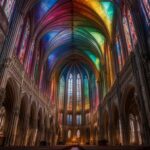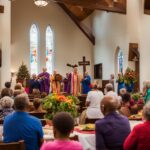Modern church architecture has undergone a remarkable transformation, embracing innovation, sustainability, and cutting-edge design concepts. Today, churches around the world showcase contemporary and minimalist aesthetics, futuristic elements, and avant-garde structures. These modern churches not only provide places for worship but also stand as architectural marvels that captivate and inspire. Let’s delve into the fascinating world of modern church architecture and explore the diverse styles that shape these sacred spaces.
Key Takeaways:
- Modern church architecture embodies innovation and sustainable design practices.
- Contemporary materials such as glass, steel, and concrete are widely used in church construction.
- Minimalist church architecture focuses on simplicity, clean lines, and open spaces.
- Futuristic church buildings feature bold shapes and cutting-edge technology.
- Sustainable church buildings prioritize eco-friendly design and renewable materials.
The Use of Contemporary Materials and Techniques
Modern church architecture embraces the use of contemporary materials and techniques to create unique and innovative structures. Architects incorporate sustainable design practices, integrating materials such as glass, steel, and concrete into their designs. This fusion of contemporary materials and innovative techniques allows for the creation of avant-garde structures that defy traditional notions of church architecture.
By employing sustainable design principles, architects not only create visually striking churches but also contribute to the preservation of the environment. The use of eco-friendly materials and energy-efficient systems ensures that modern church buildings are as sustainable as they are aesthetically pleasing.
Take a look at some of the remarkable examples below:
| Church | Location | Materials | Architect |
|---|---|---|---|
| Cathedral of Saint Mary of the Assumption | San Francisco, USA | Reinforced concrete, glass | Raphael Moneo |
| The Crystal Cathedral | Garden Grove, USA | Glass, steel | Philip Johnson |
| The Church of Light | Ibaraki, Japan | Concrete, glass | Tadao Ando |
“Contemporary materials and techniques offer architects the opportunity to push the boundaries and create truly remarkable structures. The combination of innovative design and sustainable practices is paving the way for a new era of modern church architecture.”
The use of modern architecture in designing and building churches has several advantages. Here are some to consider:
- Functionality: Modern architecture values utility and function over form. Modern churches can be designed to specifically suit the needs of the congregation, such as spaces for community meetings, youth activities, and so on.
- Efficient Space Use: Modern architectural design is more effective in utilizing spaces, making even compact areas seem spacious and comfortable.
- Cost-effective: Modern church architecture often uses more readily available materials which can be more economical. Also, simpler structures may have lower maintenance costs in the long run.
- Energy Efficiency: Many modern designs incorporate green technologies that improve energy efficiency such as solar panels or natural lighting and ventilation, reducing environmental impact and energy costs.
- Accessibility: Modern architecture usually prioritizes accessibility, ensuring that people of all abilities can easily navigate and participate in the church activities.
- Modern Aesthetics: A modern design can be an effective way to appeal to younger generations, making the church more enticing to all age groups.
- Flexibility: Modern designs often incorporate open floor plans, which can be easily rearranged for different activities.
- Integration of Technology: Modern church architecture often incorporates technology like acoustic design for sound systems, screens for presentations, and live-streaming capabilities.
- Maintenance: Modern buildings are often designed to minimize upkeep efforts with finishes and materials that last longer and are easier to clean.
- Symbolism: Modern architecture provides opportunities to include meaningful symbolism related to Christian faith in innovative ways.
While traditional architecture has its own charm and historical significance, modern church architecture aligns well with the practical and aesthetic considerations of the present day, effectively bridging the gap between the past and the future.
Minimalist Church Architecture
Minimalist church architecture embodies the essence of simplicity, emphasizing clean lines and open spaces. These designs strip away excessive ornamentation, allowing the pure form of the structure to take center stage. By embracing minimalism, churches create a serene and uncluttered environment that encourages contemplation and spiritual reflection.
Minimalist churches often feature large, open interiors that evoke a sense of tranquility. The absence of unnecessary embellishments fosters a serene atmosphere, allowing worshipers to focus on their spiritual journey without distractions. The emphasis on clean lines in these architectural marvels creates a harmonious balance between form and function.
“Simplicity is the ultimate sophistication.” – Leonardo da Vinci
Minimalist architecture celebrates the beauty of unadorned spaces, paying homage to the principle that less is indeed more. By showcasing the inherent elegance in simplicity, these churches bring forth a sense of pure connection and spirituality.
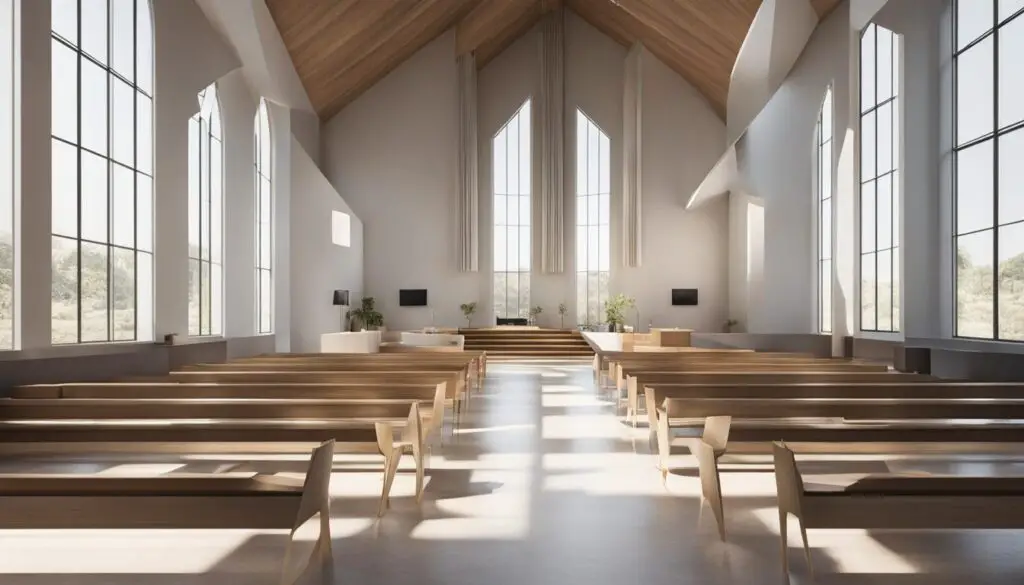
Incorporating Natural Elements
Minimalist church architecture often incorporates natural materials such as wood and stone, further accentuating the connection to nature and the earth. These organic elements add warmth and texture, enhancing the overall visual appeal of the space.
Light plays a vital role in minimalist church design, with large windows and open skylights inviting abundant natural light to flood the interiors. This creates a sense of openness and serenity, as well as a tangible connection to the outside world. The interplay of light and shadow adds depth and dimension to the space, enhancing the overall aesthetic experience.
Creating Intimate Sanctuaries
Minimalist churches often feature intimate sanctuaries, providing a more personal and immersive worship experience. These smaller spaces within the larger structure allow for a deeper sense of connection and contemplation. Visitors can find solace and peace within these sacred nooks, fostering a sense of spiritual introspection.
The Power of White
White is a dominant color in minimalist church design, symbolizing purity and spirituality. The use of a predominantly white color palette enhances the sense of simplicity and tranquility within the space. The white walls and ceilings allow natural light to bounce off, resulting in a soft, ethereal glow that permeates the entire church.
Table: Notable Features of Minimalist Church Architecture
| Feature | Description |
|---|---|
| Clean Lines | Emphasis on sleek, uncomplicated architectural lines |
| Open Spaces | Utilization of large, unobstructed interiors with ample room for contemplation |
| Natural Materials | Incorporation of organic elements, such as wood and stone |
| Abundant Natural Light | Use of large windows and skylights to infuse the space with natural light |
| Intimate Sanctuaries | Inclusion of smaller, secluded spaces for personal reflection |
| Predominantly White Color Palette | Symbolic use of white to evoke purity and spirituality |
Futuristic Church Buildings
The future of church architecture is characterized by innovative design, bold shapes, and cutting-edge technology. Futuristic church buildings push the boundaries of traditional design, creating awe-inspiring spaces for worship.
Architects of futuristic churches embrace bold shapes and avant-garde structures to create a distinct visual impact. These buildings often feature sleek, curved exteriors that defy conventional notions of church design. By challenging the status quo, these visionary architects create spaces that inspire and captivate.
The use of cutting-edge technology is a hallmark of futuristic churches. Architects harness the power of technology to enhance the worship experience and create spaces that resonate with the congregation. From state-of-the-art audiovisual systems to immersive lighting installations, technology is seamlessly integrated into the design, elevating the spiritual ambiance.
The image below showcases the innovative design and bold shapes of futuristic church buildings:

| Features of Futuristic Church Buildings |
|---|
| Bold shapes and avant-garde structures |
| Use of cutting-edge technology |
| Sleek, curved exteriors |
| Distinct visual impact |
Through innovative design, bold shapes, and cutting-edge technology, futuristic church buildings create sacred spaces that inspire worshipers and propel the evolution of church architecture.
Sustainable Church Buildings
In an era when environmental conservation and sustainable practices are paramount, the construction industry is embracing eco-friendly design solutions. This trend extends to the realm of religious architecture, with sustainable church buildings gaining popularity. These structures prioritize the use of renewable materials and energy-efficient systems, making them both visually appealing and environmentally responsible.
Architects who specialize in sustainable church design integrate various strategies to minimize the environmental impact of these buildings. One essential aspect is the careful selection of renewable materials. These materials not only reduce the consumption of natural resources but also contribute to the creation of a greener future. Examples of renewable materials commonly used in sustainable church buildings include responsibly sourced wood, bamboo, and recycled materials like reclaimed timber and glass.
To further enhance the sustainability of these structures, architects incorporate energy-efficient systems. These systems reduce energy consumption and provide a more sustainable alternative to conventional systems. For instance, the installation of solar panels on church rooftops allows for the generation of clean and renewable energy. Natural ventilation systems ensure optimal air circulation, reducing the reliance on mechanical cooling and heating methods.
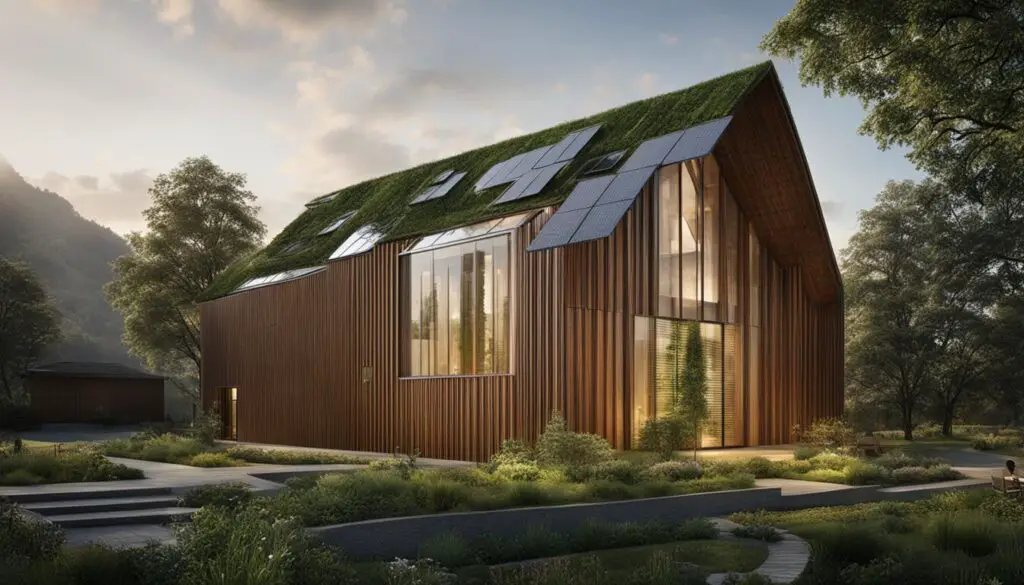
By prioritizing sustainable practices, churches are not only affirming their commitment to the environment but also inspiring their congregations to lead eco-conscious lives. Sustainable church buildings serve as physical embodiments of environmental stewardship, highlighting the role of faith communities in creating a more sustainable future.
Furthermore, sustainable church buildings are designed to provide a harmonious blend of functionality and aesthetics. These structures seamlessly integrate sustainability features into their architectural design, creating spaces that are both visually stunning and environmentally friendly. The focus on sustainability extends to the interiors as well, with natural lighting, energy-efficient fixtures, and low VOC (volatile organic compound) materials promoting a healthy and sustainable environment.
As churches continue to embrace sustainable design, they serve as beacons of inspiration for both their congregations and the wider community. These buildings demonstrate that sustainable practices can be seamlessly integrated into architectural design without compromising functionality or beauty. By prioritizing sustainability, churches play a vital role in fostering a more environmentally conscious society.
Innovative Church Structures
In the world of modern church architecture, innovative structures are pushing the boundaries of design with their unconventional and unique shapes. Architects are boldly experimenting with spatial arrangements, creating dynamic and engaging spaces for worship. These innovative church structures captivate and inspire visitors, providing a truly transformative experience.

Architects challenge traditional design norms by thinking outside the box and creating unconventional churches that defy expectations. From daring geometric shapes to whimsical and organic forms, these structures stand as tangible representations of the creative human spirit.
Unconventional Designs
Unconventional designs are at the forefront of modern church architecture. Architects are breaking away from traditional, symmetrical layouts and experimenting with asymmetry, irregular shapes, and unexpected angles. These unconventional designs create visually striking and thought-provoking buildings that draw people in and inspire wonder.
“Innovation is about taking risks and daring to dream beyond conventions. The unconventional designs of modern church structures challenge the status quo and create new possibilities for sacred spaces.” – [Architect Name], Renowned Architect
Unique Shapes
Unique shapes are a hallmark of innovative church structures. Architects are exploring a wide range of shapes, from sweeping curves to angular and jagged forms. These unconventional shapes give each church its own distinct identity and make a bold architectural statement.
“Every unique shape tells a story. The design of modern church structures reflects the aspirations and spiritual journey of the congregation, resulting in truly extraordinary and impactful spaces.” – [Architect Name], Visionary Architect
Spatial Experimentation
Spatial experimentation is a key element in creating innovative church structures. Architects play with scale, height variations, and the distribution of spaces to create a sense of dynamism and intrigue. These experimental spatial arrangements enhance the worship experience, providing a multi-dimensional and immersive environment.
“Spatial experimentation allows us to challenge preconceived notions of how a church should be. By exploring new ways of organizing space, we create designs that engage both the senses and the spirit, inviting congregation members to connect with their faith in a profound way.” – [Architect Name], Boundary-Pushing Architect
Innovative church structures represent the daring spirit of modern architecture, where creativity knows no bounds. These unconventional designs, unique shapes, and spatial experimentation reshape the concept of traditional churches, creating awe-inspiring spaces that inspire worshipers.
The Influence of Art and Culture
Modern church architecture is not only influenced by architectural principles but also draws inspiration from art and culture. Architects incorporate symbolic elements into the design, creating spaces that reflect the cultural values and beliefs of the communities they serve. These artistic elements add depth and beauty to the interiors, immerse worshipers in a meaningful experience, and enhance the overall worship atmosphere.
Symbols of Faith and Spirituality
Symbolism plays a crucial role in modern church architecture, representing various aspects of faith and spirituality. Stained glass windows, for example, are a prominent artistic feature in many churches. They not only add color and beauty to the interiors but also serve as visual representations of religious stories, teachings, and symbols. The play of light through the stained glass creates a captivating ambiance, evoking a sense of reverence and awe.
“Art enables us to find and lose ourselves at the same time.” – Thomas Merton
Integration of Sculptures and Murals
In addition to stained glass, sculptures and murals are commonly used to enhance the aesthetic appeal and spiritual ambiance of modern churches. Sculptures of religious figures or symbolic representations are often placed strategically within the church to inspire worshipers and create a connection with the divine. Murals, on the other hand, can depict biblical stories or evoke emotions through their vivid depiction of scenes from religious texts.
Tables with Religious Symbols
| Religious Symbol | Meaning |
|---|---|
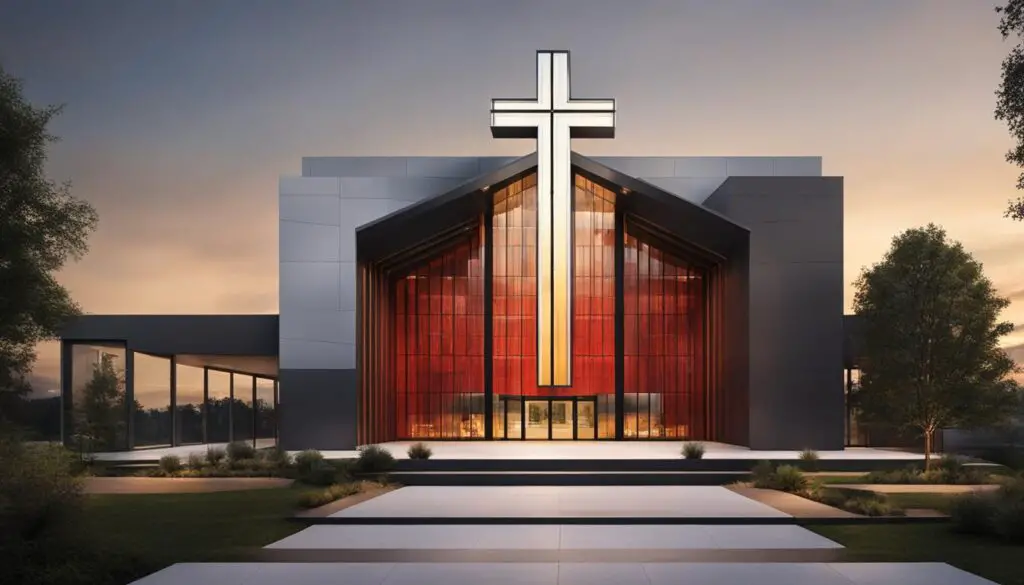 | The cross symbolizes the crucifixion of Jesus Christ and represents the central tenet of Christianity. |
| The dove is often associated with the Holy Spirit and represents peace, purity, and divine presence. | |
| The fish symbolizes Jesus Christ and the early Christian community, representing faith, abundance, and unity. |
Incorporating these artistic elements into the design of modern churches adds a layer of symbolism that resonates with worshipers, inviting them to connect on a spiritual and emotional level. The interplay between architecture, art, and culture creates a harmonious environment for worship, evoking a sense of inspiration, devotion, and transcendence.
Noteworthy Examples of Modern Church Architecture
Modern church architecture has produced several iconic designs that have garnered recognition and admiration. These remarkable structures showcase the innovative and creative possibilities within the realm of modern church design. Let’s explore some of the most notable examples:
The Cathedral of St. Mary of the Assumption
The Cathedral of St. Mary of the Assumption, located in San Francisco, California, stands as a testament to modern church architecture. Designed by Pier Luigi Nervi and Pietro Belluschi, this magnificent structure embodies the principles of contemporary design. Its bold geometric shape, soaring concrete framework, and stunning stained glass windows create a harmonious blend of spirituality and architectural beauty.
Hallgrímskirkja
Situated in Reykjavík, Iceland, Hallgrímskirkja is a truly awe-inspiring example of modern church architecture. Designed by Guðjón Samúelsson, this striking structure dominates the city skyline with its towering presence. The design draws inspiration from Iceland’s natural landscapes, featuring clean lines and a unique expression of volcanic rock formations. The interior of the church is equally impressive, housing a powerful pipe organ and providing breathtaking views from its observation deck.
Parish Church of Santa Monica
In Barcelona, Spain, the Parish Church of Santa Monica stands as a testament to creativity and innovation in modern church architecture. Designed by David Chipperfield Architects, this contemporary church offers a unique blend of traditional and modern elements. Its captivating façade showcases a pattern of perforated aluminum panels, allowing streams of natural light to filter into the interior and create a tranquil atmosphere.
These examples represent the diversity and ingenuity within modern church architecture. From the Cathedral of St. Mary of the Assumption in the United States to Hallgrímskirkja in Iceland and the Parish Church of Santa Monica in Spain, these structures inspire awe and reverence through their iconic designs.
Embracing Technology in Church Design
Modern church architecture seamlessly integrates technology, bringing a new dimension to the worship experience. Through the incorporation of digital integration and multimedia elements, churches are able to engage and inspire their congregation like never before.
One of the key ways modern churches embrace technology is through the use of audiovisual systems. These systems enhance the worship experience by providing immersive visuals and crystal-clear sound. From high-definition projection screens to state-of-the-art sound systems, technology creates a dynamic environment that draws worshippers closer to their spiritual journey.
Projection mapping is another innovative technique used in modern church architecture. By projecting stunning visuals directly onto the surfaces of the church, projection mapping creates a captivating visual experience that enhances the storytelling aspect of worship. This technology allows for creativity and flexibility, enabling churches to transform their spaces into immersive and interactive environments.
Technology allows for dynamic and immersive services, creating a sense of unity and connection within the congregation.
LED lighting is yet another impactful element in modern church architecture. Churches utilize LED lights to create dramatic lighting effects that enhance the ambiance of the worship space. With the ability to customize colors, brightness, and patterns, LED lighting adds depth and visual interest to the architectural design.
By embracing technology, churches are able to create sacred spaces that are not only visually stunning but also spiritually uplifting. The integration of technology brings a sense of unity and connection within the congregation, fostering a deeper engagement with the worship experience.
Creating Sacred Spaces for Contemporary Worship
Modern church architecture recognizes the importance of creating sacred spaces that align with contemporary worship practices. These designs go beyond traditional aesthetics and focus on inclusivity, accessibility, and fostering a sense of community. By embracing inclusive design principles, modern churches strive to ensure that everyone, regardless of physical ability or background, can fully participate in the worship experience.
This commitment to inclusive design is reflected in the architectural elements and layout of modern churches. For example, ramps and elevators are incorporated to provide easy access for individuals with mobility challenges. The use of tactile materials and braille signage enhances the experience for those with visual impairments. Acoustic considerations help create a welcoming environment for individuals with hearing disabilities. Inclusive design not only removes barriers but also communicates an important message of acceptance and unity within the congregation.
Contemporary worship practices often involve dynamic and interactive elements. Modern church architecture accommodates these practices by incorporating flexible spaces that can be easily adapted for different activities. Multi-purpose areas can be used for worship services, community events, and educational programs. Technology integration allows for seamless audiovisual presentations, enhancing the worship experience and creating a sense of spiritual connection.
In addition to inclusivity and flexibility, modern church architecture focuses on creating sacred spaces that inspire and uplift. Natural light is strategically utilized to create a serene and contemplative atmosphere. The use of environmentally friendly materials emphasizes a connection to nature and sustainability. Symbolic elements, such as stained glass windows or artwork, add depth and meaning to the worship space.
The design of modern church architecture aims to facilitate a sense of awe and reverence, allowing worshipers to connect with their spirituality on a deeper level. These sacred spaces become a sanctuary where individuals can find solace, peace, and a sense of belonging. The contemporary design principles balance tradition and innovation, ensuring that the worship experience is relevant to the needs of the modern congregation.
“The architecture of a worship space should be a reflection of the values and beliefs of the congregation it serves. It should be a sanctuary that invites and embraces all, creating an inclusive and transformative worship experience.”
By prioritizing inclusivity, accessibility, and a sense of community, modern church architecture creates sacred spaces that cater to the diverse needs and preferences of contemporary worshipers. These designs not only provide functional and aesthetically pleasing environments but also foster spiritual connection and growth. With their emphasis on inclusive design, modern churches offer a warm welcome to all who seek solace, inspiration, and a deeper understanding of their faith.
Conclusion
The world of modern church architecture is constantly evolving, embracing innovative trends and pushing the boundaries of design. As we look to the future of church design, we can expect to see even more advancements in technology, sustainable practices, and unconventional shapes.
Architects will continue to respond to the changing needs and preferences of worshipers, creating transformative spaces that inspire and engage. The integration of advanced technologies, such as digital integration and multimedia elements, will enhance the worship experience and foster a sense of unity within the congregation.
Additionally, sustainability will play a key role in the future of church design. Architects will prioritize eco-friendly practices, utilizing renewable materials and energy-efficient systems to reduce the environmental impact of these structures. This commitment to sustainability not only aligns with the values of many religious communities but also contributes to a greener future for all.
With each passing year, modern church architecture continues to amaze and inspire. By embracing innovative trends and incorporating cutting-edge design concepts, architects around the world are creating sacred spaces that cater to the needs of contemporary worship. As we move forward, the future of church design holds the promise of even more remarkable and awe-inspiring structures.
FAQ
What is modern church architecture?
Modern church architecture refers to the contemporary design styles and innovative structures used in the construction of churches. It embraces elements such as sustainable design, minimalist aesthetics, futuristic shapes, and avant-garde materials.
What are some examples of contemporary materials used in modern church architecture?
Architects use a variety of contemporary materials in modern church architecture, including glass, steel, and concrete. These materials offer durability, flexibility, and aesthetic appeal, allowing for the creation of unique and avant-garde structures.
What is minimalist church architecture?
Minimalist church architecture focuses on simplicity, clean lines, and open spaces. It eliminates excessive ornamentation and embraces a more minimalistic approach to design, creating a serene and peaceful environment for worship.
How do futuristic church buildings differ from traditional designs?
Futuristic church buildings push the boundaries of design with their bold shapes and innovative use of technology. They often feature sleek, curved exteriors and incorporate cutting-edge materials, creating visually striking structures that challenge traditional design norms.
What are sustainable church buildings?
Sustainable church buildings are designed with eco-friendly practices in mind. They prioritize the use of renewable materials and incorporate energy-efficient systems, such as solar panels and natural ventilation, to reduce environmental impact and contribute to a greener future.
How do innovative church structures differ from traditional church architecture?
Innovative church structures challenge traditional design norms by incorporating unconventional and unique shapes. Architects experiment with spatial designs, creating dynamic and engaging spaces for worship that captivate and inspire visitors.
How does modern church architecture incorporate art and culture?
Modern church architecture draws inspiration from art and culture, incorporating symbolic elements into the design. These structures reflect the cultural values and beliefs of their communities, creating a meaningful and immersive experience for worshipers.
Can you provide any examples of notable modern church architecture?
There are several noteworthy examples of modern church architecture, including the Cathedral of St. Mary of the Assumption in the United States, the Hallgrímskirkja church in Iceland, and the Parish Church of Santa Monica in Spain. Each of these structures represents the innovation and creativity found within modern church architecture.
How does technology play a role in modern church architecture?
Modern church architecture embraces technology by incorporating digital integration and multimedia elements into the design. Churches utilize audiovisual systems, projection mapping, and LED lighting to enhance the worship experience, creating a sense of unity and connection within the congregation.
How does modern church architecture cater to contemporary worship practices?
Modern church architecture focuses on creating sacred spaces that cater to contemporary worship practices. These designs prioritize inclusivity and accessibility, ensuring that everyone can fully participate in the worship experience. The architecture facilitates a sense of community and spiritual connection, enhancing the overall worship atmosphere.
What does the future hold for modern church architecture?
The future of church design is expected to incorporate even more advanced technology, sustainable practices, and unconventional shapes. As the needs and preferences of worshipers change, architects will respond with designs that inspire and engage, creating transformative spaces for worship.


